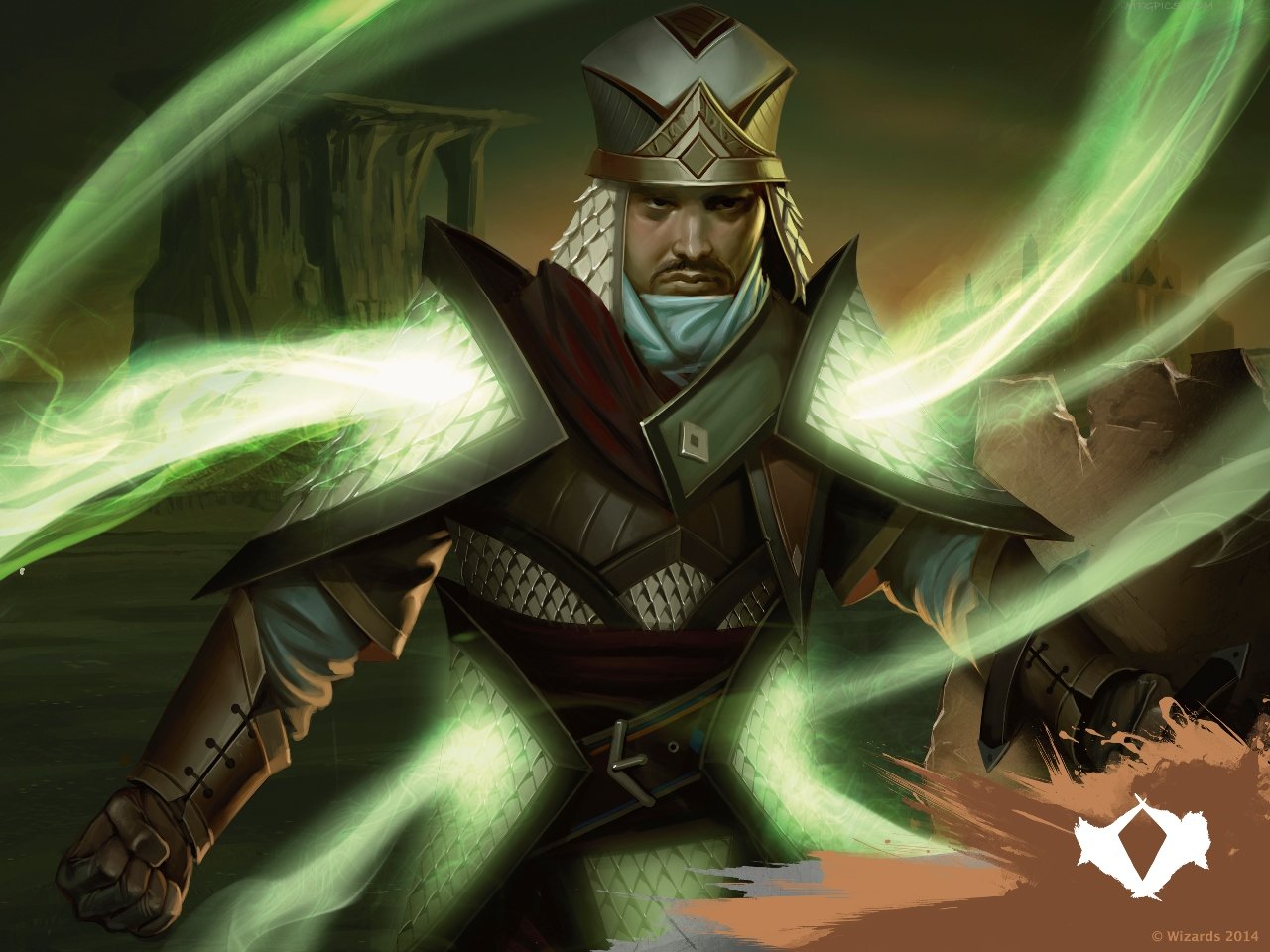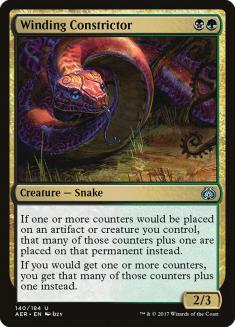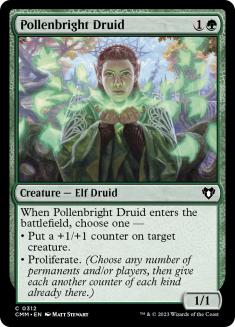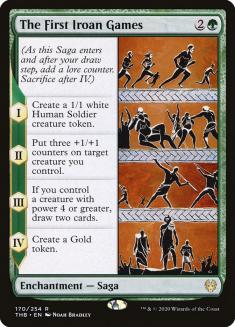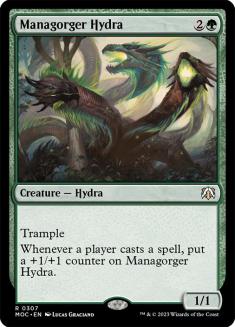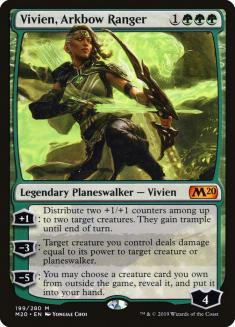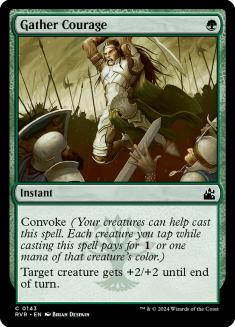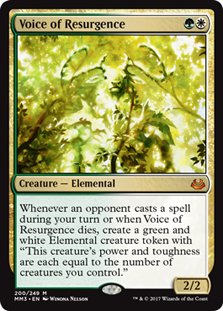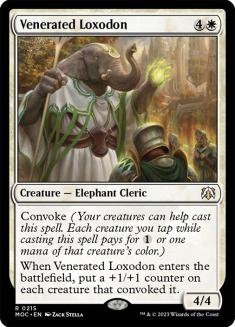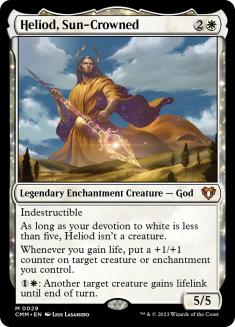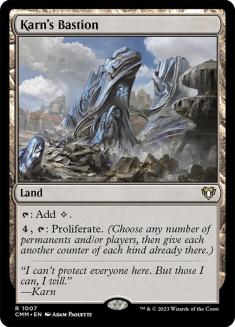It all started this morning.
Creatures (20)
- 4 Llanowar Elves
- 1 Scavenging Ooze
- 4 Elvish Mystic
- 4 Walking Ballista
- 3 Pollenbright Druid
- 4 Huatli's Raptor
Planeswalkers (8)
Lands (22)
Spells (10)

I don’t really know how to say this, but I got hooked. I didn’t get it at first. I think it’s kinda hard to grasp that The First Iroan Games is suddenly the third-best card in Hardened Scales. It’s tough to understand that Pollenbright Druid is somehow playable in Constructed, and damn good at that. All it takes is understanding that proliferate, when built around, is actually pretty disgusting. Part of that is due to building your deck to abuse token and +1/+1 potential a la Hardened Scales, and another part is adding counters to the powerful enchantment cycle: Sagas.
After seeing this deck on paper go 4-1 in a Pioneer Prelim on Magic Online, a relatively difficult tournament compared to your average League opponent, I was intrigued. Perhaps it was a fluke, but maybe it would make for some good content. But the more I thought about it, the more I realized how ridiculous all these cards were when combined. I mean, The First Iroan Games? Really? Okay, I guess I’ll give it the old college try.
So I put this deck together and fired up the stream, ready to do battle and see what this thing was all about. My first match was against Mono-Red Aggro, a relatively tough matchup for decks featuring Llanowar Elves, and especially so if they also have Goblin Chainwhirler. But the cards just kept coming together, even in the face of Wild Slash and Stomp. I cast The First Iroan Games, and I used proliferate to add counters to it in various spots to do some ridiculous stuff, including adding five counters to a Walking Ballista with a pair of Hardened Scales at the ready!
Long story short, I got hooked. Plain and simple, this deck caught me off-guard. Ultimately, I went 2-3 in the League I was playing, but all three losses were three-game sets that were quite close, and I felt like this iteration could be greatly improved. This was a rough draft, and I was going to spend the day tweaking slots and trying different color combinations. Ultimately, I thought that having so many creatures with proliferate might not be necessary, and we were only splashing for Huatli’s Raptor and the Heliod combo on top of a few sideboard cards. Why not try the better manabase that Golgari has to offer?
It is no secret that Winding Constrictor fits right into this strategy. If Pollenbright Druid didn’t exist, I might heavily consider moving into Abzan to play all the pieces to this beautiful puzzle. The obvious restriction to doing this is the manabase, but maybe we can just play four Pollenbright Druid and have the best of both worlds. The Heliod combo is only splashed via Vivien, Arkbow Ranger anyway. And it’s not like losing Rest in Peace is that big of a deal.
So here’s where I ended up:
Creatures (22)
- 4 Llanowar Elves
- 4 Elvish Mystic
- 2 Managorger Hydra
- 4 Winding Constrictor
- 4 Walking Ballista
- 4 Pollenbright Druid
Planeswalkers (8)
Lands (22)
Spells (8)

Similar concepts, but seemingly less “cute” stuff and more of the Hardened Scales goodness you’ve come to know and love. I always thought that losing Once Upon a Time killed this archetype, but these new additions and small alterations are really starting to draw me back in! Having cards that are modal, in that they are good both early- and late-game, is the key. If you’re happy drawing a two-drop creature on the fifth or sixth turn, that’s a win in my book, and that’s exactly the type of card you want in a fair Pioneer deck.
The sideboard black cards are a big draw for this version too. Thoughtseize helps in every combo matchup and has some chops against control too. Fatal Push is a nice tool for increasing interaction among the format’s other aggressive decks. While it is good, going too hard on cheap removal isn’t ideal, if only because you need to keep your threat density relatively high and can’t afford to cut planeswalkers or your creatures.
I just want to say that Pollenbright Druid is not a joke. If you saw it in action, you’d understand immediately how powerful proliferate can be. In fact, after playing my first League with this core of Hardened Scales, I went and searched up every legal card in the format that had that keyword. Unfortunately, there weren’t too many good options, but it wasn’t all bad. We had one in pure green, and another with a splash of white. There were a few noncreatures that were relatively weak and not worth much consideration, but the versatility of Pollenbright Druid can’t be overstated.
If your opponent is a control deck, it functions as a Runeclaw Bear. And if you slam Hardened Scales on the first turn, it becomes a bit more Watchwolf-esque. But the creme de la creme comes when you get to proliferate on multiple creatures, planeswalkers, and even Sagas. It’s outrageous. I don’t know how to get that point across any more clearly. It’s just ridiculous.
Pollenbright Druid and cards like it offer the Hardened Scales something it doesn’t really have access to without them: overload. No, I’m not talking about the old Izzet mechanic. I’m talking about the phenomenon that happens in a deck when it goes from being good to great. It’s that one thing the deck’s been missing, keeping it from being Tier 1. It’s the good stuff.
I know I’ve talked about this card a bit, but I have to say it’s been very impressive. Not only is it a way to give you card advantage, it provides bursts of pressure that work incredibly well with Walking Ballista, all while giving you a good target for proliferate. The card draw aspect is pretty sweet, as it helps create a snowball effect that occasionally takes the attention away from your more important enabler or payoff permanents.
I mean, it’s not like your opponent can ignore it. If they don’t kill the 1/1, you end up with a 4/4, two extra cards, and a Gold token at the very least! That’s pretty incredible for three mana, but you also have to remember that you’re not living in a vacuum. Almost every deck you face will have removal, discard, or counters, or potentially be faster or more explosive than you. Balancing all those concepts is tough, but The First Iroan Games passes the test of “Is this card still good if your opponent is killing all your stuff?”
This one’s a heater. I only had it in one League, but I was pretty impressed by it. Outside of costing three mana and being vulnerable to removal on the first turn you cast it, Managorger Hydra almost always killed my opponent when I got to attack with it. If you have Hardened Scales or Winding Constrictor, every single spell cast by any player gives it an extra counter. And because you have The First Iroan Games, this deck actually has some velocity when it comes to drawing cards and casting multiple spells in a single turn. It’s also another card that can give value to draw Elves later in the game.
While it “just attacks and blocks,” I liked what I saw when playing Managorger Hydra. With that said, I think there’s a good chance that Voracious Hydra is slightly smaller, but overall a more versatile and desirable option.
I’ve thought about trimming this down to two copies a few times, but every time I do I end up missing it. After all, it just does everything you need it to do. Killing opposing planeswalkers or creatures is pretty sick, but the biggest upside is just pumping the heck out of your small creatures and turning them into real threats. It helps make drawing those Llanowar Elves palatable in the late-game.
Vivien, Arkbow Ranger was just incredible in Mono-Green Devotion, but that was a long time and a lot of banned cards ago. My love for it might be based a little too much on past results, but it’s looked pretty good so far. Plus it just gets ludicrous when you can give you extremely large Snakes trample to carry you home.
The ultimate is also surprisingly relevant, even if we’re not using Nykthos, Shrine to Nyx to cast Ulamog like the good ol’ days. Instead, we’re taking a more surgical approach, looking for creatures that are good in multiple situations and can be sideboarded in if necessary. Some of these are no-brainers, but just remember that having access to such a powerful suite of tools has traditionally be pretty good across Magic’s long history. Wish cards can find a home, and Vivien, Arkbow Ranger seems to fit this deck perfectly on multiple metrics.
I felt like a red deck could be problematic for us, and Gather Courage was a card I remembered being particularly ridiculous when paired with Managorger Hydra. All of your creatures except Walking Ballista are green, so it’s almost always free. It’s nothing all that new, and I’m sure I’m not the first person to put it in my green-based deck’s sideboard, but it’s something a lot of people haven’t really thought about or possibly even seen before.
It just so happens that every red deck in Pioneer is playing Wild Slash and Stomp, so having a free spell to counter those that also makes combat a bit trickier for the opponent is pretty darn good! While the metagame is primarily full of combo decks at the moment, I feel like having a few cards to counteract one of your tougher matchups might be worthwhile.
After playing a few Leagues with this core, with a few variations here and there, I decided to move back into Selesnya. I thought there was something missing from the initial list that I just couldn’t put my finger on. After all, both versions were essentially base green with a light splash. Could we get a little bit heavier?
Voice of Resurgence was the card that kept popping up in my head. Its body wasn’t that threatening, but preventing your opponent from interacting on your turn makes all your decisions a lot easier. Targeting for The First Iroan Games isn’t as tricky, and a lot of other decisions just become simple. It also helps that it’s a great blocker and punishes people for trying to counter all your payoff cards!
But the kicker above everything else was a creature that actively punished your opponent for casting Supreme Verdict. Leaving you with an X/X creature that you can immediately pump via all your cheap creatures or token generators is dangerous. In fact, all the extra buffs you can give that token can sometimes just kill the opponent outright. Their best card, Supreme Verdict, is often just not good enough! The first iteration had so much trouble with Supreme Verdict that he played Heroic Intervention in the maindeck! Voice of Resurgence had to be the answer!
It turns out that Voice of Resurgence was solid, but I didn’t really “feel” it when I played with it. But that’s almost always the case. Cards like Voice of Resurgence or perhaps Mausoleum Wanderer are tough to deduce exactly how good they are, because the opponent starts to play differently when they’re around. While it might not look like their ability is relevant, the opponent is often playing in such a way to prevent you from using that ability to your advantage.
After testing the Selesnya version again with some changes like Voice of Resurgence, here’s where I ended up after twenty or so matches with the Hardened Scales archetype.
Creatures (21)
- 3 Llanowar Elves
- 4 Voice of Resurgence
- 3 Elvish Mystic
- 4 Walking Ballista
- 3 Pollenbright Druid
- 4 Huatli's Raptor
Planeswalkers (8)
Lands (23)
Spells (8)

When playing more two-drop creatures, starting on Llanowar Elves or Elvish Mystic is less important. The Selesnya version also plays Sunpetal Grove, which means you have fewer untapped green sources on the first turn. Overall, I felt like losing the Elves might be a mistake, but I still drew them often and didn’t feel like I was flooding on them as much.
Voice of Resurgence was solid. It never made a token outside of dying, but it did force the opponents to play poorly against the cards I presented them turn after turn. They’d often ignore the Voice of Resurgence itself, which meant it kept dealing them damage and kept forcing them to cast everything on their own turn.
Some of the sideboard cards felt like overkill, but I think that’s always going to be the case as the format seems to be constantly in flux. Just about a month ago, Bonecrusher Giant was one of the best cards in Pioneer. Now? Well, let’s just say it’s no longer in my “Top 5 Cards in the Format.”
Before I go, I wanted to give you a short list of stuff I want to try. I think some of these have promise, and wanted to give you ideas to brew on your own, but with the knowledge that this last bit is all theorycrafting and conjecture.
Abzan Scales
I want to try a full-blown Abzan version of the deck, complete with Mana Confluence, Concealed Courtyard, and Blooming Marsh for all the fast mana you can stomach. Since the deck is base-green, all you really need is roughly twelve to fifteen sources of each other color. And if you only have four cards of each splash color, I think thirteen or fourteen makes me comfortable.
It’s tough to fit this card into a deck that doesn’t have a lot of white creatures. If you can’t ever get this to cost zero, it’s a lot less desirable. But a more traditional Selesnya Tokens build featuring Venerated Loxodon might be ridiculous. Venerated Loxodon is definitely worse in a deck with Llanowar Elves than it would be in a more aggressive strategy. I mean, the big draw of convoke is that any creature “becomes” a Llanowar Elves until end of turn. Having actual Llanowar Elves is a bit redundant.
Venerated Loxodon will be a an outrageous addition to this deck if you can get everything to work. When paired with Hardened Scales, it just does some amazing stuff. You just need to find a few more white creautres to help with that convoke cost!
This one seems obvious, but my previous assessment of the Heliod-Ballista combo is that you really need to be able to turn it on. Having Heliod, Sun-Crowned be a creature just means you’re using your cards to their fullest potential. I found the white-based devotion decks did some good work with making Heliod into a real piece of the deck instead of just a combo enabler with Walking Ballista.
Maybe there’s a base-white version of the deck that runs the Heliod-Ballista combo and Venerated Loxodon too? A boy can dream.
This one was in the original versions of Hardened Scales because they could pump your whole team. I found the colorless nature of the card made it hard to get value out of because you had so few colorless symbols in your spells. That can be fixed in some ways, but I think one or two copies could be good. After all, we are playing eight Llanowar Elves in our deck. Putting that extra mana to good use could be sick.
If you want to make Karn’s Bastion good, you need to treat it like a spell that “gets to tap for mana.” Much like Mutavault or Ramunap Ruins, it functions as both land and spell, so increasing your land count slightly is okay. Giving yourself stuff to do when you flood is sick, but hitting your land drops so you get to cast your important three- and four-drops on time is clutch.
The New Hardened Scales
This deck is in its infancy, folks. The First Iroan Games was the shot in the arm that this deck needed to survive, and the card that brought us to a more degenerate build. Huatli’s Raptor and Pollenbright Druid work together to do something really special. If your opponent isn’t interacting with you, that big brick of synergy can knock out most combo decks before they’re perfectly set up. That pressure forces them to act too quickly, often fizzling and dying.
The rest of your deck is full of cards that are both explosive and resilient. The planeswalkers work well in all versions, giving you insulation from sweepers as well as virtual card advantage whenever they get going. And most importantly they give you more ways to put counters on your creatures, making the proliferate abilities all the more potent. Nissa, Voice of Zendikar is particularly busted here, as giving your horde of Elves and various other creatures extra counters is just gross.
The most recent results from the Players Tour events gave me pause about the potential health of Pioneer, but playing this deck has given me a bit of new hope. It’s powerful, proactive, and customizable. I mean, I even considered trying a blue splash for Hadana’s Climb! I don’t know where I’ll end up exactly, but my gut says the core of this deck is really good. I’m looking forward to a quality deep dive.

